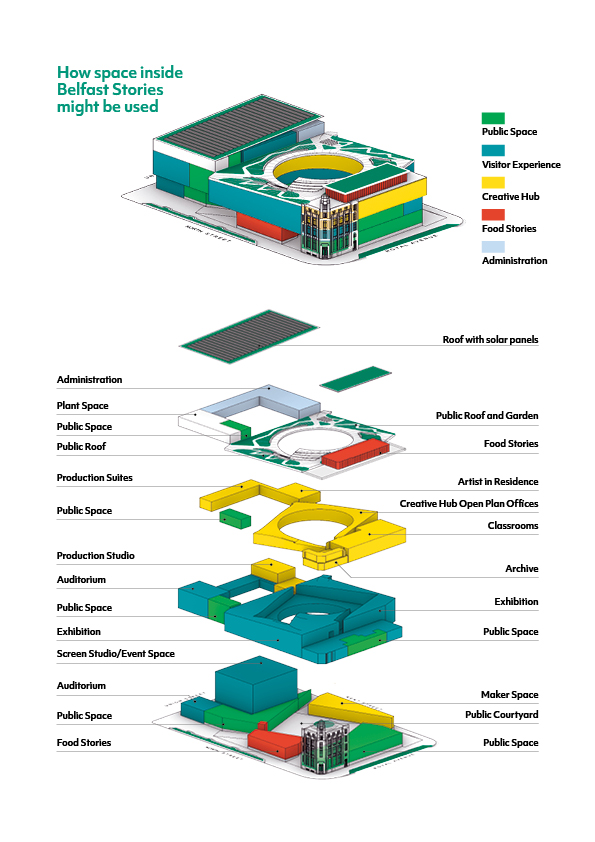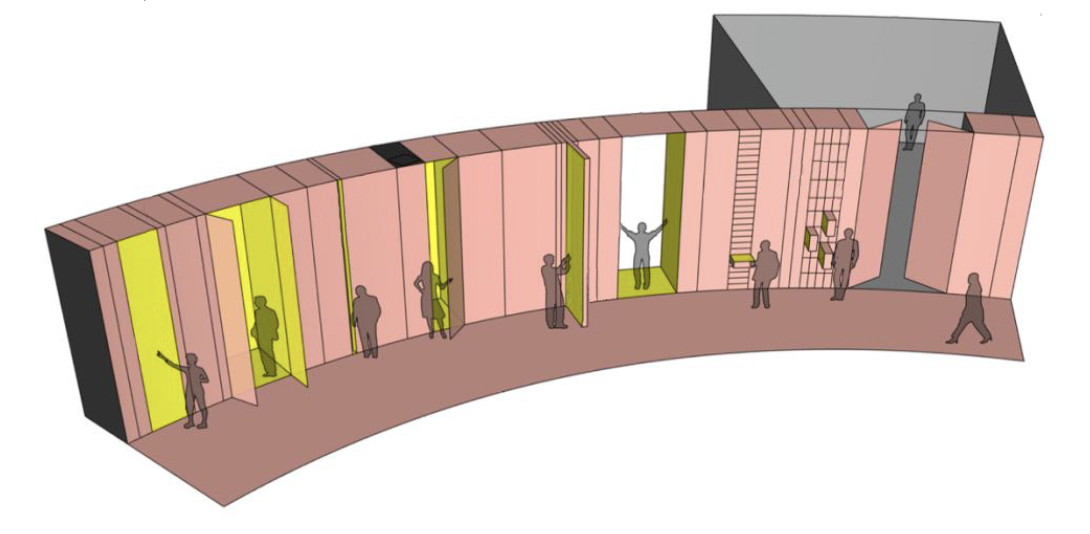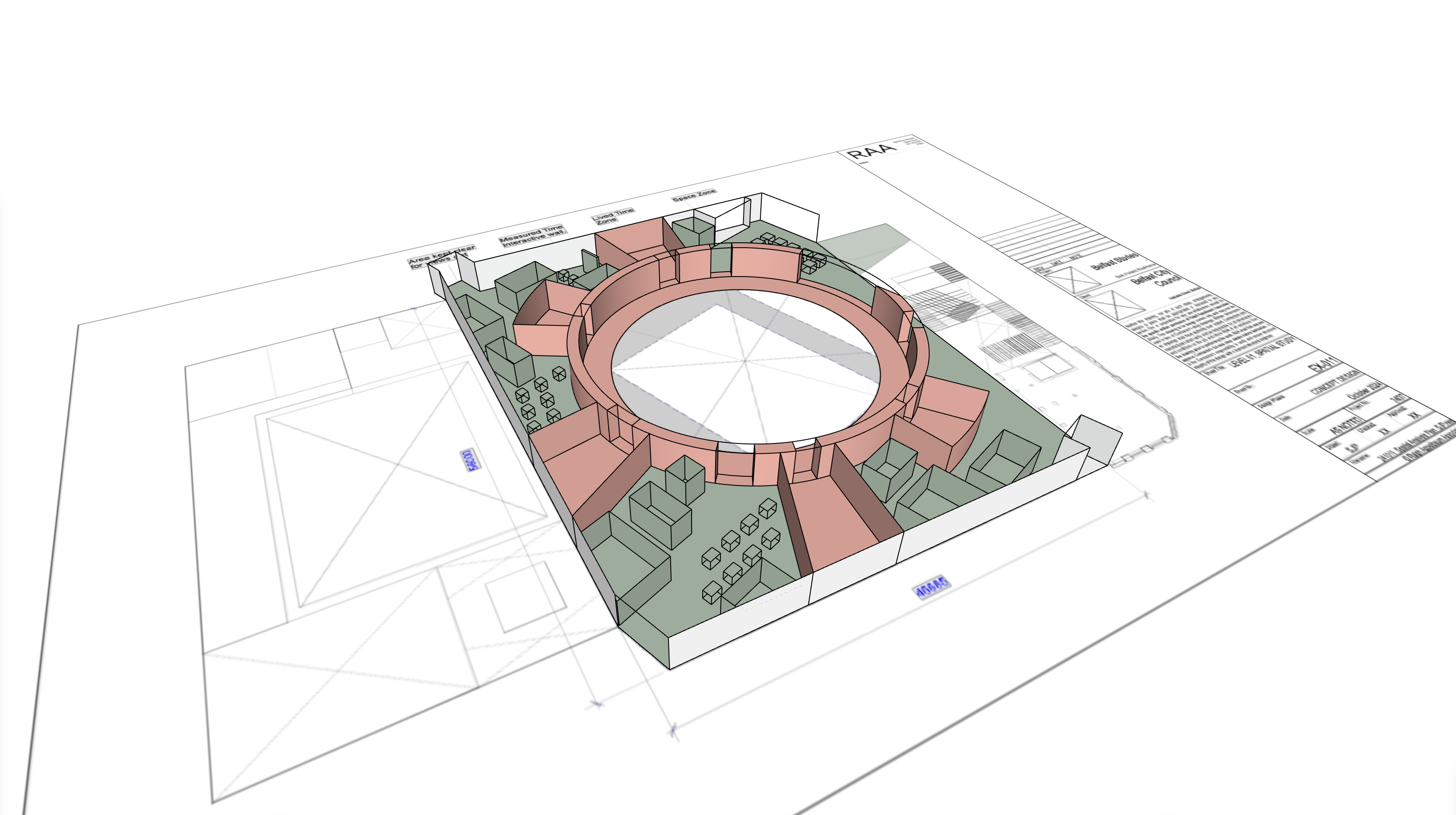What might Belfast Stories look like?
Seeing is believing.
Different? Good. A bit unorthodox? I hope so. That’s Belfast for you – we have to start letting the city speak for itself. We need to be more out there.
Tricky enough
Designing a concept such as Belfast Stories is an intricate and multi-layered process involving, the design of both the structure itself and the experiences that will attract people in. These aspects are intimately linked to the ongoing feedback we receive from the public (see section 4). What constitutes good in terms of a building’s visual appearance is often a contentious issue, but we want the Belfast Stories building to become a familiar and loved feature of Belfast’s cityscape. To do that, Belfast Stories needs to be a brave and confident architectural statement.
Best in the building
The striking Art Deco former Bank of Ireland building is proposed as a focal point, spreading out over a 5,000 m² site.
We want Belfast Stories to be an impressive and memorable sight.
First and foremost, we are proposing a welcoming building with four broad entrances to its central public space, allowing inclusive access to all facilities. Visitors can follow a gentle sloping path to a rooftop with views across the city to the Belfast Hills beyond. The rooftop itself will be natural playground, inviting people to relax and interact with its unique places, spaces and features.
In 2023, following an international design competition, Oslo-based Snøhetta architects in partnership with Belfast-based TODD Architects were appointed to lead on the architectural design of Belfast Stories, working with Gillespies on landscape design. They are currently designing initial concepts for further development and testing.
Some of these initial concepts are illustrated here, but there is a long road ahead with a great deal of discussion and consultation still to come.


No stone unturned
The design process is conducted in line with the planning stages recommended by the Royal Institute of British Architects (RIBA).
In total there are eight stages in this process. We are currently in the middle of stage 2: presenting and reviewing initial design concepts.
The next stage, (stage 3) is when these architectural and curatorial concepts will be turned into practical plans and we apply for planning permission.
At that point there will be further consultation with the public and with the project’s diverse network of stakeholders. By the time we have reached Stage 7 and the building is ready for use, we will have completed a meticulous development process, ensuring that Belfast Stories will be an asset valued by many future generations.
How Belfast Stories is applying the RIBA stages
- Definition. The team decides if the project is a good idea. They define what is needed and if it's worth doing.
- Preparation and briefing. The team starts to plan, gather information, define building needs and outline budget and timeline. Architects and experiential designers are appointed and briefed.
- Concept design. Early designs are made to show what the building could look like and how it might work. These ideas are shared and discussed. (We are at this stage: public consultation on Concept Design for the building and what might be inside it).
- Spatial coordination. The design is developed in more detail. The layout, materials, and systems are decided to make sure everything fits together.
- Technical design. Detailed designs are created for construction. These include technical drawings and specifications for contractors to follow.
- Manufacturing and construction. Building is constructed, with materials ordered, workers on site, and the design is turning into reality.
- Handover. Once complete, the building is handed over to get ready for opening.
- Use. The building is used and maintained. The team may review how well it meets the original goals and see if any improvements are needed.
Experience this
Design of the Belfast Stories building goes hand-in-hand with developing the experiences inside it. This is being led by designers Ralph Applebaum Associates working with Barker Langham.
This is a work in progress that is being influenced and shaped by the outcomes of our ongoing engagement with Belfast’s people. There will be two distinct elements to this aspect of Belfast Stories – the ticketed exhibition part of the building and the activities in other parts of the building that will invite people from across the city and beyond to share their stories in a huge variety of different ways.
A rolling programme of story-gathering events and activities both in the building itself and at other locations inviting participants from every part of our Belfast community will be invited. We call this our story engine.

Building on the spirit of Belfast, we will embrace the unexpected, inviting people to look up, around, underneath and participate to the fullest. We will build immersive storytelling moments. We are considering a series of structures that invite you to physically interact with the stories. These will vary in scale and permanency from small granular displays to large installations.


Worth the entrance fee
The main exhibition will allow people to take their own journey through stories that are told in a myriad of different ways – interactive, audio-visual, musical, printed - and in ways that are yet to be imagined.
In our many conversations across Belfast to date, it became clear that people didn't want their stories arranged by themes or put in a box. It was good thinking.
How could we ever subdivide and codify our diverse and individual experiences of being in or from Belfast?
Belfast Stories isn’t a museum, it’s a space for ideas and emotions and a call to creative thinking. It’s an open, porous experience filled with opportunity for thought and conversation, sadness and laughter, art and music.
Time and place will frame our stories. These may be challenging, ironic, emotional, sentimental, experimental, provocative, or evocative.
They can be anything people want - a first stolen kiss or the last bus home; Saturday at the match or Sunday at Granny’s; a big night out or a quiet night in, but all from this cast iron, red brick, black-humoured, kind and complex place. A hands on, no holds barred, celebration of Belfastness. Prepare to be surprised.
Never-ending story
We call it the story engine, shorthand for an ever-developing programme of activities both inside and outside the Belfast Stories building in which we shape, store and share the stories that we gather and make.
How will this be done? Think of as many ways as you can of telling and recording stories and then ask someone else to think of a new one. Lots. Online, in person, on film, in verse, written down, recounted, sung, acted, whispered, shouted, regretted, rewritten, forgotten, begun again, reconstructed, half-remembered, true, half true or completely imagined. We like stories in Belfast. We’re good at telling them. Let’s prove it.
The stories that we tell and the ways in which we share them have to reflect the ideas and passions of the people that own them, you. We can’t make Belfast Stories without bringing the people of Belfast with us. The next section explains how we are doing that.
